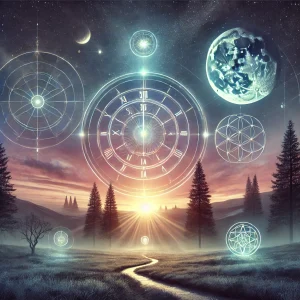 The use of symbolic dates and times has a deep resonance within psychedelic practices, where timing often aligns with personal intentions, cosmic events, or numerological patterns to enhance the meaning of the experience. Below, we explore how the significance of dates and times—like 11:11 or others—has evolved in psychedelic practices and the broader symbolic landscape of ceremonial timing.
The use of symbolic dates and times has a deep resonance within psychedelic practices, where timing often aligns with personal intentions, cosmic events, or numerological patterns to enhance the meaning of the experience. Below, we explore how the significance of dates and times—like 11:11 or others—has evolved in psychedelic practices and the broader symbolic landscape of ceremonial timing.
For members of Psychedelics in Recovery (PIR), finding meaningful rituals and symbols can enhance their journey of self-discovery, healing, and spiritual growth. Psychedelic experiences often open the door to deeper understanding and alignment with oneself and the universe, and many members draw on symbolic dates and times—like 11:11, solstices, or personal milestones—as anchors for reflection and intention-setting. These moments become meaningful rituals within their recovery, helping them to stay connected, grounded, and committed to their path. By aligning with sacred timing, members can transform ordinary moments into powerful, purposeful acts that support their ongoing journey in recovery.
1. The Significance of 11:11 in Psychedelic Ceremonies
For many people involved in psychedelic ceremonies, especially those integrating spiritual practices, the time 11:11 has become a powerful moment to pause, reflect, and set intentions. Here’s how it’s used:
- Intention-Setting: During a ceremony, facilitators or participants might observe 11:11 as a time to set or reaffirm intentions, seeing it as a “portal” to align with their highest goals for the experience.
- Mindfulness Practice: When 11:11 appears, participants may take a moment to focus on their breathing, tune into the present moment, and center their awareness, creating an ideal mental space for deep introspection.
- Collective Unity: For group ceremonies, 11:11 is sometimes a prompt for group meditation or prayer, a time to harmonize energies and bring focus to collective intentions for healing or transformation.
2. Solstices and Equinoxes: Sacred Timing for Transformation
Solstices (December 21 and June 21) and equinoxes (March 20 and September 22) have been used for centuries by indigenous and spiritual communities as powerful times for ceremonies, including those involving psychedelics. These times are often seen as points of energetic alignment, ideal for rites of passage, renewal, and transformation.
- Winter Solstice: Known as the longest night of the year, the Winter Solstice is a time of darkness, contemplation, and the promise of rebirth. Many see it as an ideal moment to “go inward” in ceremony, seeking insights about shadow aspects, releasing the past, and setting intentions for growth.
- Summer Solstice: The Summer Solstice, when daylight is at its peak, is often celebrated with outdoor ceremonies, celebrating life, abundance, and the spirit of connectedness. Many use it as a time to honor the body, nature, and the interconnectedness of all life.
- Equinoxes: As days and nights are equal, the equinoxes symbolize balance. Psychedelic ceremonies during equinoxes may focus on restoring internal balance, harmonizing energies, or letting go of inner conflict, allowing for a more peaceful and centered journey.
3. Full Moons and New Moons: Lunar Phases for Amplified Intentions
The lunar cycle has long been central to spiritual practices, and many psychedelic practitioners incorporate full moons and new moons into their ceremonial timing:
- Full Moon Ceremonies: The full moon represents illumination, culmination, and the completion of cycles. Many find it a powerful time to dive into psychedelic experiences that offer insights, clarity, or closure. In group settings, full moon ceremonies are often held outdoors under moonlight, symbolizing openness and collective expansion.
- New Moon Ceremonies: The new moon, which marks the start of the lunar cycle, is a time for fresh intentions, goal-setting, and planning. Psychedelic ceremonies during the new moon may be quieter, reflective, and focused on seeding intentions for the coming cycle. Some people may use these ceremonies for personal clarity on new paths, career changes, or spiritual growth.
4. Numerologically Significant Dates (e.g., 1/1, 2/2, 3/3, etc.)
Some psychedelic practitioners are drawn to dates with repeating numerals (like 1/1, 2/2, or 12/12) for ceremonial practices, seeing these dates as carrying high vibrational frequencies and specific symbolic meanings. For example:
- 1/1 (New Year’s Day): Representing new beginnings, many choose this date to “reset” through ceremony, letting go of the past year’s challenges and setting intentions for the year ahead.
- 2/2, 3/3, etc.: Some choose these dates for their symbolism in numerology. For instance, 2/2 is associated with duality and balance, while 3/3 represents creativity and expression. Practitioners may use these dates to align their psychedelic journey with these themes, seeking insight or growth in areas symbolized by the numbers.
- 12/12: Seen as a highly spiritual date, 12/12 ceremonies are often focused on completion, reflection, and gratitude for the entire year, especially potent when combined with intentional use of psychedelics.
5. Astrological Transits: Cosmic Alignments in Ceremonial Timing
Astrology often plays a significant role in the timing of psychedelic ceremonies, especially during impactful planetary alignments like eclipses, retrogrades, or specific planetary transits.
- Eclipses: Eclipses (solar and lunar) are viewed as potent energetic portals that bring transformation and clarity, though they can also be intense and emotionally charged. Some practitioners use eclipses as an opportunity to dive into shadow work, clearing emotional baggage or confronting unresolved trauma.
- Mercury Retrograde: Although often seen as a challenging time, Mercury retrograde can be a period of introspection and reassessment. For psychedelic ceremonies, it can be a time to reflect on past decisions, unresolved issues, and patterns, though some practitioners may avoid ceremonies during this time due to potential emotional intensity.
- Planetary Transits (e.g., Saturn Return): Some people align ceremonies with personal astrological events, such as their Saturn Return (around ages 27-30 and 57-60), a period often associated with significant life changes. These transits can serve as opportunities for transformative journeys, often with psychedelics used as tools for understanding and accepting life shifts.
6. Personal Milestones and Anniversaries: Personal Reflections in Ceremonial Timing
Many individuals in psychedelic practices also choose specific personal milestones, like birthdays or anniversaries, as significant times for ceremony.
- Birthdays: Known as “solar returns,” birthdays can be seen as moments of rebirth. Practitioners may use psychedelics ceremonially to reflect on the past year, release limiting beliefs, and set intentions for the new year.
- Sobriety Anniversaries: For individuals using psychedelics as part of a recovery process, anniversaries of sobriety can be meaningful times for ceremony. It may serve as an opportunity to reflect on the journey, honor personal growth, and recommit to their path.
- Life Transitions: Significant life changes, like moving, career changes, or relationship shifts, can also be marked by ceremony. Practitioners use psychedelics to explore these transitions more deeply, seeking clarity, guidance, and healing as they move into new chapters of life.
7. Collective Dates for Healing and Transformation (e.g., Earth Day, World Mental Health Day)
Certain global observances, such as Earth Day (April 22) or World Mental Health Day (October 10), are also chosen by some psychedelic practitioners for group ceremonies or individual journeys. These dates can carry themes that resonate with larger causes and global healing, inspiring participants to focus on collective well-being.
- Earth Day: For example, Earth Day may inspire a ceremony focused on nature connection, sustainability, and gratitude for the environment. Plant medicines or psychedelics may be used to deepen this connection, allowing participants to feel a renewed sense of ecological awareness.
- World Mental Health Day: On World Mental Health Day, psychedelic ceremonies might be aimed at exploring personal mental health, processing trauma, or supporting healing around mental health issues. These ceremonies often emphasize community, support, and a commitment to holistic well-being.
Intentional Timing for Deepened Ceremonial Experiences
In psychedelic practices, the timing of ceremonies often aligns with symbolic dates or cosmic events, chosen to deepen the meaning of the experience. Whether through 11:11, solstices, numerologically significant dates, or personal anniversaries, these moments serve as powerful “portals” that enhance the journey. For those on a path of self-discovery and healing, the alignment of ceremony with symbolic times is more than mere timing—it is an intentional and thoughtful way to weave personal intention with universal energies, honoring both the individual and the collective journey of transformation.




